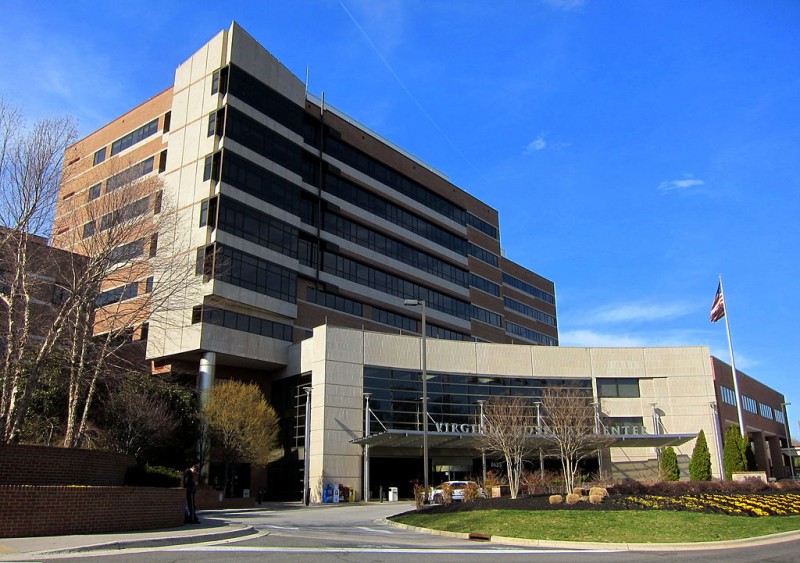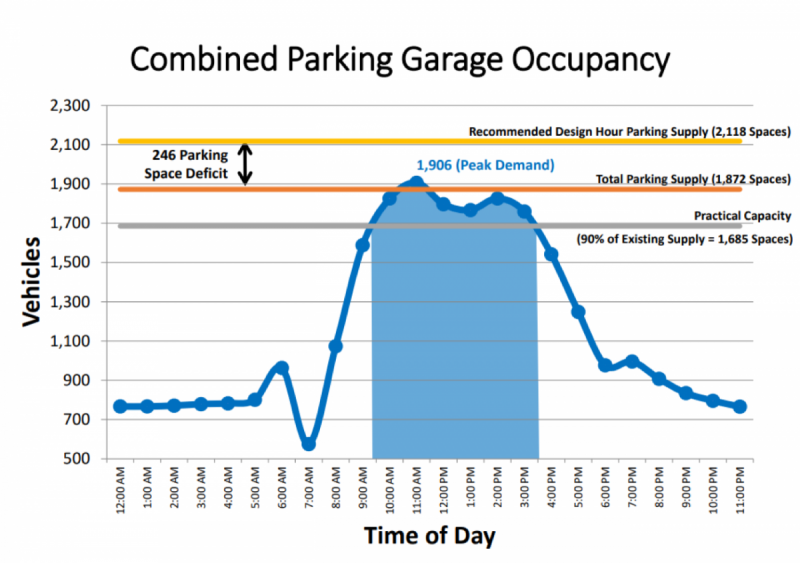Virginia Hospital Center in Arlington is at urbanist odds with its neighbors

Image by AgnosticPreachersKid licensed under Creative Commons.
Virginia Hospital Center (VHC) in Arlington wants to expand its facilities, including a new outpatient center and a 2,000-car parking garage free for employees. While neighbors and local advocates generally support the hospital and its expansion, both groups have major concerns about the proposal.
Neighbors are primarily frustrated with the height and mass in close proximity to single-family homes, while advocates dislike the large number of parking spaces and plans to subsidize driving. Emergency room patients aren’t likely to bike, walk, or take transit to the hospital, but employees, visitors, and those going to routine office visits certainly could.
Proposed design for the expansion, looking southeast on 19th Street. 
Here's what’s happening with the hospital expansion
Virginia Hospital Center sits just outside the Rosslyn-Ballston corridor, about a 1.5-mile walk from the Ballston Metro, in a residential neighborhood made up of single-family homes and modest townhouses. To expand, it wants to swap land with Arlington County, which currently owns the remainder of the block that VHC occupies. In exchange, Arlington would get other land that VHC owns on South Carlin Springs Road, plus some cash.
Hospital officials claim there is already a parking shortage and that the new outpatient center will require even more parking. Their data backs up this claim, but only as it pertains to on-site parking.
To supplement the on-site parking, VHC leases 460 off-site parking spaces and provides a free parking shuttle for employees. Of those spaces, only about 40% are utilized. It also leases a 90-space surface lot on county land that will go away as part of the development.
VHC initially proposed adding an additional 2,000 parking spaces to the site via a 10-story parking garage with eight stories above ground and two below. They have recently reduced that to about 1,800 parking spaces and put an additional floor below ground, after staff and the Transportation Commission pushed back.
The community has concerns
Neighbors’ primary concern is the size and design of the parking garage and outpatient building. Even with the reduced parking garage size, the garage and outpatient center are still significantly taller than nearby homes. The new buildings present an uninterrupted and nearly blank wall to the neighborhood.
Proposed design for the expansion, showing a view of George Mason Drive and 19th Street. 
There are also concerns about additional traffic from the expansion, especially since VHC isn’t currently planning to provide much, if any, of its own land to expand the transportation network’s capacity. A new left-turn lane on George Mason Drive would come from narrowing lanes and reducing medians, not from VHC land.
When neighbors expressed concern about garage access on 19th Street, which currently operates as a yield street (where one car has to pull over in order for another one to pass), VHC proposed removing on-street parking from one side rather than widening it.
When staff asked VHC to provide bicycle facilities along George Mason Drive to connect to a future county project, VHC’s only proposal was to widen the George Mason Drive sidewalk to eight feet rather than making room for bike lanes or even a more standard 10-foot-wide path.
Lessons from Seattle
From an urbanist perspective, this project would produce a staggering amount of parking. All told, the VHC site would end up with nearly 4,000 parking spaces with the recent small reduction — that’s almost double the number of parking spaces in the Ballston Mall garage.
Seattle Children's Hospital. Image by Sage Ross licensed under Creative Commons.
It doesn’t have to be this way. Seattle Children’s hospital is an excellent example of what VHC could achieve with a robust Transportation Demand program. Like VHC, Seattle Children’s is in a residential neighborhood that’s not well-served by transit. Nonetheless, by encouraging biking, walking, carpools, vanpools, and transit as well charging for parking, Seattle Children’s Hospital has reduced their employee drive-alone rate to 38.5%. VHC’s is almost double that at 72%.
Seattle Children’s found the most effective way to reduce driving alone was to charge their employees for parking. More specifically, it does so via a daily rate, rather than offering a more-common monthly “all you can park” package. This encourages employees to take other modes on the days that they can and drive on the days that they can’t, rather than driving every day just because they have to drive some days.
This finding lines up perfectly with Arlington’s own Transportation Demand Management (TDM) studies, which have found that the price of parking at someone’s employer is the single best determinant of whether they drive to work or not.
Arlington County Residential Building Transportation Performance Monitoring Study 2013. 
VHC claims that it must offer its employees free parking for employee retention. However, if it raised wages the same amount it was planning to charge for parking, an employee who continued to drive every day would end up making the same amount of money they are now and continue to be able to drive whenever they wanted. An employee who found a way to carpool, take transit, or bike would see an increase in their compensation.
VHC would only “lose money” on employees who didn’t need a parking space. Thanks to those employees, it could build fewer expensive parking spaces — and be a better neighbor and encourage healthier commuting choices to boot. This is similar to the DC proposal to require employers to offer a “parking cashout,” where employees who don’t take advantage of a parking benefit can instead get that benefit in cash.
What’s next for the project
VHC’s current expansion plan, while providing needed hospital capacity and a new outpatient facility, looks more like a design that would belong in the outer suburbs, not one that fits within the context of Arlington’s urban villages. Seattle Children’s hospital provides a better blueprint for moving forward, with priced parking and robust TDM reducing the need for parking and driving resulting in healthier outcomes for the hospital, the neighborhood, and the community.
The expansion will be reviewed again at its sixth Site Plan Review Committee Meeting on May 14, where VHC is expected to respond to many of the transportation concerns that the neighbors and Transportation Commission have raised. After that, it will need to go before the Planning Commission and then to the County Board for final approval.
GGWash sometimes organizes around issues affecting our region. Should we consider advocacy around this topic? Let us know!

